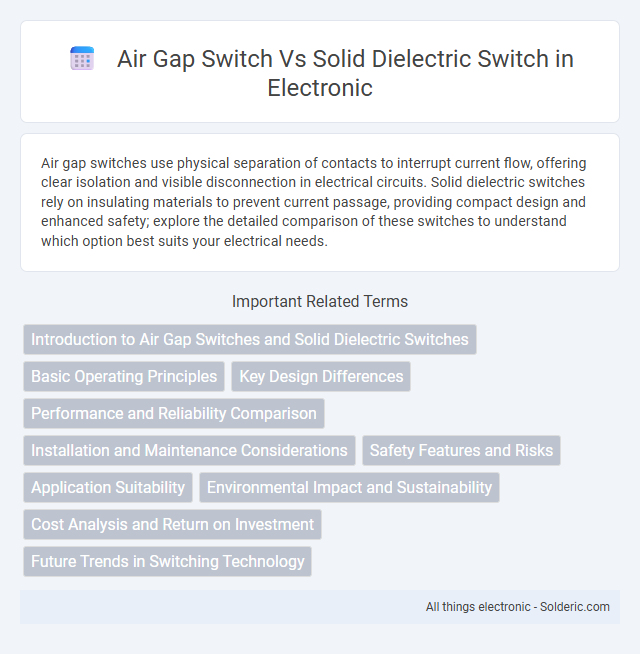Air gap switches use physical separation of contacts to interrupt current flow, offering clear isolation and visible disconnection in electrical circuits. Solid dielectric switches rely on insulating materials to prevent current passage, providing compact design and enhanced safety; explore the detailed comparison of these switches to understand which option best suits your electrical needs.
Comparison Table
| Feature | Air Gap Switch | Solid Dielectric Switch |
|---|---|---|
| Insulation Medium | Air | Solid dielectric material (e.g., epoxy, polymer) |
| Operation | Mechanical separation of contacts in air | Separation within solid dielectric material |
| Voltage Rating | Moderate to high voltage | High voltage applications preferred |
| Size | Generally larger due to air clearance needs | Compact design because of solid insulation |
| Maintenance | Requires regular inspection and cleaning | Low maintenance due to sealed insulation |
| Environmental Sensitivity | Sensitive to dust, humidity, and pollution | Less sensitive; sealed against environment |
| Switching Speed | Slower mechanical operation | Faster response possible |
| Typical Applications | Substations, overhead lines, load break switches | Compact switchgear, indoor applications |
| Cost | Lower initial cost | Higher initial cost |
Introduction to Air Gap Switches and Solid Dielectric Switches
Air gap switches utilize a physical separation between conductive contacts to interrupt electrical circuits, providing high dielectric strength through air insulation. Solid dielectric switches employ solid insulating materials such as epoxy or silicone to achieve electrical isolation and withstand voltage stress. These switches differ in insulation medium and structural design, influencing their applications in high-voltage and compact electrical systems.
Basic Operating Principles
An air gap switch operates by physically separating two conductive contacts in the air to interrupt current flow, relying on the insulating properties of the air gap to prevent arc formation. In contrast, a solid dielectric switch uses a solid insulating material, such as epoxy or silicone, to separate contacts and extinguish arcs, providing enhanced dielectric strength and compact design. Understanding the basic operating principles of these switches helps you select the right technology for efficient electrical isolation and circuit protection.
Key Design Differences
Air gap switches use a physical gap between contacts to interrupt current flow, providing clear isolation and visual confirmation of circuit status, while solid dielectric switches rely on insulating materials to extinguish arcs within a sealed environment. You will find that air gap designs typically offer simpler construction and easier maintenance, whereas solid dielectric switches enable compact sizing and improved reliability in harsh conditions. The choice between these switches depends on factors such as application requirements, environmental conditions, and safety standards.
Performance and Reliability Comparison
Air gap switches offer reliable performance by physically separating contacts, minimizing the risk of electrical arcing and ensuring clear isolation during operation. Solid dielectric switches provide enhanced durability and faster response times due to their encapsulated design, which resists environmental contaminants and reduces maintenance needs. Your choice depends on application demands, with air gap switches excelling in high-voltage isolation and solid dielectric switches delivering consistent performance in compact, enclosed environments.
Installation and Maintenance Considerations
Air gap switches require more space and manual labor during installation due to their mechanical components and physical separation of contacts, making them bulkier compared to solid dielectric switches. Solid dielectric switches feature compact designs with enclosed insulation, resulting in easier installation and reduced maintenance due to fewer moving parts and lower exposure to environmental contaminants. Your facility benefits from lower downtime and cost savings when choosing solid dielectric switches for streamlined installation and minimal maintenance requirements.
Safety Features and Risks
Air gap switches provide robust safety through physical separation of contacts, ensuring complete disconnection and visible isolation, minimizing arc flash hazards. Solid dielectric switches use insulating materials to prevent accidental contact but may lack the clear visual confirmation of isolation inherent to air gap designs. While air gap switches reduce risk of electrical shock during maintenance, solid dielectric switches require careful monitoring to detect insulation degradation and avoid potential failure.
Application Suitability
Air gap switches are ideal for high-voltage, outdoor applications due to their simple construction and effective arc quenching in open air. Solid dielectric switches excel in compact, indoor environments where maintenance-free operation and high dielectric strength are essential. Selection depends on installation context, voltage requirements, and environmental conditions to optimize performance and reliability.
Environmental Impact and Sustainability
Air gap switches contain no hazardous materials and require minimal maintenance, resulting in lower environmental risks during disposal compared to solid dielectric switches, which use insulating oils or gases with potential toxicity and disposal challenges. The solid dielectric switch's materials, often polymers or SF6 alternatives, can pose sustainability issues due to complex recycling processes and potential greenhouse gas emissions if leaks occur. Air gap switches typically offer greater sustainability through simpler, more biodegradable components, aligning better with eco-friendly infrastructure goals.
Cost Analysis and Return on Investment
Air gap switches typically have lower initial costs due to their simple construction and minimal maintenance requirements, making them attractive for budget-conscious installations. Solid dielectric switches, while more expensive upfront due to advanced insulating materials and compact design, offer longer service life and reduced maintenance expenses, enhancing long-term return on investment (ROI). Evaluating total cost of ownership (TCO) reveals that solid dielectric switches can deliver superior ROI in high-reliability applications despite higher initial capital expenditure.
Future Trends in Switching Technology
Future trends in switching technology emphasize the development of solid dielectric switches due to their compact design, higher efficiency, and reduced maintenance compared to traditional air gap switches. Innovations in advanced insulating materials and nanotechnology enhance the dielectric strength and thermal stability of solid dielectric switches, promoting their adoption in smart grid and renewable energy systems. Integration with digital monitoring and control systems further positions solid dielectric switches as key components in the evolution toward automated and resilient power distribution networks.
air gap switch vs solid dielectric switch Infographic

 solderic.com
solderic.com